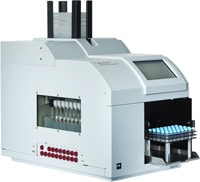Access Agilent eNewsletter, February 2014
>> Update My Profile | Subscribe to Access Agilent | Article Directory

Ask the Expert: Selecting an autosampler for the dissolution test
By Dan Spisak
Agilent Dissolution Systems Product Manager
Every laboratory has its own specific needs when it comes to improving sample throughput and efficiency, and a technique dependent test – such as dissolution – offers a natural target for implementing automation.
Dissolution tests are quite simply sample preparation steps that take place before analytical testing such as UV-Vis or HPLC analysis. There are several components that comprise the dissolution process, and all may be automated for greater precision.
The advantage of using an autosampler is that it allows the laboratory to properly centralize dissolution activity. Dissolution autosamplers, enabled by local instrument or software control, should offer an intuitive user interface as well as user-level controlled functions that can be easily maintained by an administrator, giving the ability to:
- create and store specific dissolution methods for your pharmaceutical products
- control precise and repeatable sampling and filtration from your dissolution apparatus
- document critical instrument data
- sufficiently prepare samples for subsequent UV-Vis or HPLC analysis
But what type of autosampler will be right for your particular needs and instrumentation? That’s the question you must ask before you set out to choose a particular solution.
Anyone who has worked in this industry has most likely observed an automated system going unused. One reason for this is that the specific product type chosen did not truly mesh with the laboratory’s instrumentation and usage needs – making it either over- or under-qualified for the job.
This observation shows that you should carefully evaluate your dissolution environment before making any automation system choice in order to acquire the best solution for your needs. It is important to examine the type of products being tested, the variety of dissolution methods, and internal resources available – both in terms of instruments and dissolution analysts.
Once you’ve evaluated your environment, carefully examine all of the hands-on steps in your sample protocols that have the potential to be automated. Any routinely performed process that can be carried out by an instrument will not only help you achieve greater efficiency, but also eliminate the human manipulation factors that can create variability.

Figure 1. Agilent 850-DS Dissolution Sampling Station.
Once you’ve acquired the specific information regarding your instruments, environment and automation needs, consider exactly which autosampler will provide the right match for your needs. Your instrumentation must offer compatibility with your desired USP apparatus in order to achieve the semi-automation advantage that the autosampler provides. To account for the variability of dissolution methodology, additional features such as full or partial media change capabilities, filtering of samples and the ability to have a variety of dissolution media types, including those containing surfactants, are especially important.
With these facts in hand, you are now ready to choose an autosampler such as the newly-released Agilent 850-DS Dissolution Sampling Station, which offers both automated filtering and sampling capabilities (Figure 1). Wherever your new-found knowledge takes you, you’ll know that the instrument you’ve purchased won’t sit unused in a corner of your lab.
To learn more about automation solutions and other considerations for your dissolution laboratory read the article, "Considerations for Automating the Dissolution Test" by G. Bryan Crist, Agilent’s Scientific Affairs Manager, which appeared in Dissolution Technologies. Then take a moment to explore the many advantages of the Agilent 850-DS Dissolution Sampling Station to see if it’s the right choice for your lab.
>> Update My Profile | Subscribe to Access Agilent | Article Directory